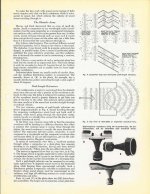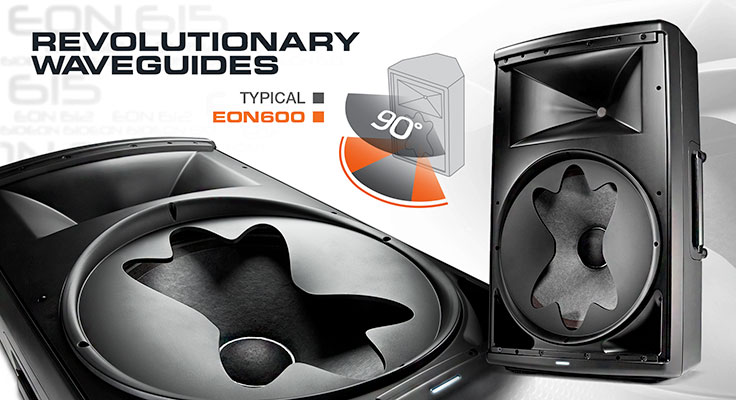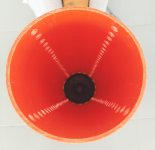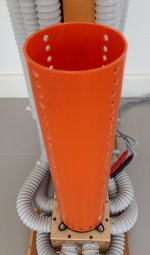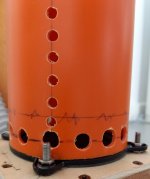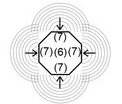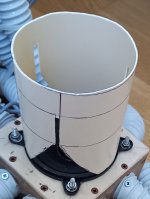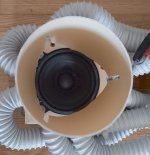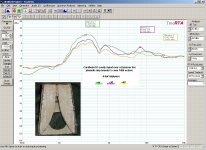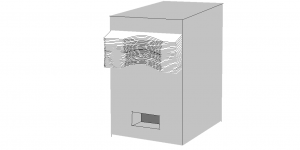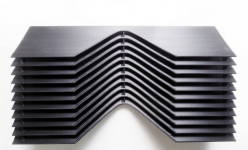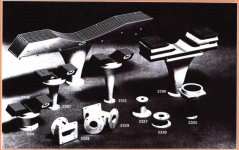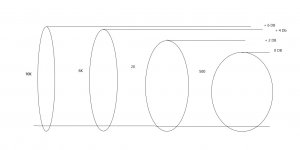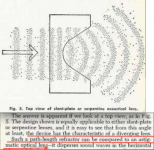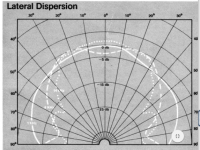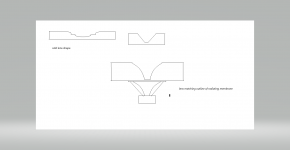Has anyone tried to affix one of those beautiful JBL type slotted lens in front of a full-ranger?
The horrific beaming at high frequencies seems to be the perpetual Achilles heel that holds us full-rangers back from greatness. No doubt the careful expansion rates within horns really "makes" those lens' work as well as they do....& the gaps & the expansion inconsistencies just might make the whole thing "fall apart".
Has anyone got any ideas?
----------------------------------------------------------------------------Rick....
The horrific beaming at high frequencies seems to be the perpetual Achilles heel that holds us full-rangers back from greatness. No doubt the careful expansion rates within horns really "makes" those lens' work as well as they do....& the gaps & the expansion inconsistencies just might make the whole thing "fall apart".
Has anyone got any ideas?
----------------------------------------------------------------------------Rick....
Attachments
I'm not an expert, but I used JBL 2308 lenses on both 2391 (with 2420 driver) and 2392 (with 2440 driver) and the lens would have to be designed to operate over the full range of the driver.
The 2308 for example is a small lens and not intended for operation at low frequencies, as the frequency goes down it starts to loose control of the vertical dispersion. You'd need a pretty big one to maintain control down to 100Hz or so..
Personally I didn't think they sounded bad, but the technology for directivity control has progressed quite a bit since that time.
The 2308 for example is a small lens and not intended for operation at low frequencies, as the frequency goes down it starts to loose control of the vertical dispersion. You'd need a pretty big one to maintain control down to 100Hz or so..
Personally I didn't think they sounded bad, but the technology for directivity control has progressed quite a bit since that time.
Attachments
JBL used to market a budget version of their massive Hartsfield speaker that used an 8" d208 extended range.
It was backloaded into a horn, and it had a "Koustical Lens" in front of it to increase the dispersion.
HARTSFIELD
It was backloaded into a horn, and it had a "Koustical Lens" in front of it to increase the dispersion.
HARTSFIELD
Has anyone tried to affix one of those beautiful JBL type slotted lens in front of a full-ranger?
The horrific beaming at high frequencies seems to be the perpetual Achilles heel that holds us full-rangers back from greatness. No doubt the careful expansion rates within horns really "makes" those lens' work as well as they do....& the gaps & the expansion inconsistencies just might make the whole thing "fall apart".
Has anyone got any ideas?
----------------------------------------------------------------------------Rick....
JBL engineers used diffraction to send most of the acoustic energy to listeners. For home listening I use diffraction to obtain a 360 degree emission on the horizontal plane with very simple and cheap devices.
First example: triple profile type Karlson
MDDFL
Second example: single waveguide with the same diameter as the drive with four series of holes.
MDDFL
My web site: Claudio Gandolfi - MDD (Multi Delays Diffraction Loudspeaker)
My thread: MDD Multi Delays Diffraction (Multi TL, omnidirectional, single drive, ...)
Attachments
you could make a little cardboard test karlson "front chamber" say a 20 degree baffle angle wedge just large enough to cover the driver. The aperture may be made tighter than what Karlson, as to influence horizontal polars.
here's a lens in front of a Dynavox "phenolic ring" tweeter - horizontal dispersion is good for 120 degrees up to 20KHz
You can try the JBL lens in cardboard, etc. scale and print the image below to fit the driver120 dispersion - try a Karlson wedge shaped chamber with aperture which overlaps part
of the cone.
JBL style lens - scale as necessary and print:
https://i.imgur.com/E3MneZr.jpg
I want to try my 8 inch B&C in the enclosure below plus a cheap 1.5" format compression driver
on a K-tube sitting above the midrange module. (my good internet friend John Lapaire made these for me)

here's a lens in front of a Dynavox "phenolic ring" tweeter - horizontal dispersion is good for 120 degrees up to 20KHz
You can try the JBL lens in cardboard, etc. scale and print the image below to fit the driver120 dispersion - try a Karlson wedge shaped chamber with aperture which overlaps part
of the cone.
JBL style lens - scale as necessary and print:
https://i.imgur.com/E3MneZr.jpg
I want to try my 8 inch B&C in the enclosure below plus a cheap 1.5" format compression driver
on a K-tube sitting above the midrange module. (my good internet friend John Lapaire made these for me)

Attachments
Last edited:
The 2308 Lens should work OK "as is" on speakers around the exit diameter of the horn they were used on- 4 and 1/8 inch diameter.
That said, I preferred the sound of the "beaming " 2307, 2311, 2312 horns over the "warm, fuzzy" "astigmatic" sound the lens' diffraction causes.
2308 copies are easy to cut out of 1/16" plastic sheet material.
Art
That said, I preferred the sound of the "beaming " 2307, 2311, 2312 horns over the "warm, fuzzy" "astigmatic" sound the lens' diffraction causes.
2308 copies are easy to cut out of 1/16" plastic sheet material.
Art
Attachments
Wow, didn't take long for some of you to careen down the verbial rabbit hole...didn't cha?
In the prose of anthropomorphism, I can add another nonsensical word attributing to a character of sound..."ASTIGMATIC".
Bright, muddy, warm...move over, we now have a new champion.
Go right ahead & mark the floor, X marks the spot if you wish for being able to hear those Hi-hats.
Myself, I move from time to time.
--------------------------------------------------------------------------Rick......
In the prose of anthropomorphism, I can add another nonsensical word attributing to a character of sound..."ASTIGMATIC".
Bright, muddy, warm...move over, we now have a new champion.
Go right ahead & mark the floor, X marks the spot if you wish for being able to hear those Hi-hats.
Myself, I move from time to time.
--------------------------------------------------------------------------Rick......
Attachments
Rick,Wow, didn't take long for some of you to careen down the verbial rabbit hole...didn't cha?
In the prose of anthropomorphism, I can add another nonsensical word attributing to a character of sound..."ASTIGMATIC".
The apt comparison of the 2308 style horn "lens" to an astigmatic optic lens was from the attachment you included in your original post.
The description makes sense of the way the horn lens works.
Though the horn lens does spread out sound waves horizontally, allowing you to hear the hi-hat cymbals and other high frequency sounds a bit further off-axis, the sonic effect in visual terms is a smeared (unclear) image.
You can see the "smearing" in the lateral dispersion, 14kHz is reduced on axis by 6dB compared to 4kHz, and sent off to a pair of peaks left/right 25 degrees off axis. Not visible in the chart is the overall attenuation of high frequency going through the lens causes, not much of a problem with a two-way system, but would require EQ correction using a full range speaker.
Cheers,
Art
Attachments
Smearing implies an interaction ...as in two-frequencies creating harmonics above and below as in a non linear device. But if this was the case, the collection of frequencies in music with each two creating multiples of...music as a whole wouldn't exist.
There is a nodal effect going on I haven't learned of yet.
JBL created the potato-masher, the slant-plate, and the serpentine type lens', but this was about it for the lens development...the acoustic lens was dropped when the dome tweeter was developed.
Perhaps JBL was working on nulling out these lobing effects with the more complex serpentine lens.
There is little data I have found as of late, little bits here & there...one the notation of half an inch or less of slant plate "gaps" near 10K hz.
There is one mention of the lens matching the contour of a radiating cone or membrane.
So much more to discover.
-----------------------------------------------------------------------Rick......
There is a nodal effect going on I haven't learned of yet.
JBL created the potato-masher, the slant-plate, and the serpentine type lens', but this was about it for the lens development...the acoustic lens was dropped when the dome tweeter was developed.
Perhaps JBL was working on nulling out these lobing effects with the more complex serpentine lens.
There is little data I have found as of late, little bits here & there...one the notation of half an inch or less of slant plate "gaps" near 10K hz.
There is one mention of the lens matching the contour of a radiating cone or membrane.
So much more to discover.
-----------------------------------------------------------------------Rick......
Attachments
Last edited by a moderator:
I learned pretty much all I wanted to know about the potato-masher, slant-plate, and the serpentine type "lenses" listening to them back in the late 1970's, but discovering the science behind how they do what they do is a good thing, the attachment in the OP aided my understanding.
Thanks,
Art
Thanks,
Art
A multicellular horn can be placed in front of an FR driver with no detriment like resonating cavities or combfiltering.
It can be as simple as a single wing sticking straight out splitting the wavefront into two.
Or it can be very elaborate including reflectors as part of the design.
It can be as simple as a single wing sticking straight out splitting the wavefront into two.
Or it can be very elaborate including reflectors as part of the design.
Speed of sound
Speed of sound is very slow in rubber so I thought that probably speed of sound in a silicone elastomere is also slow. Make a plastic mold in a 3D printer. It may be a good idea to use some release agent before pouring the fresh silicone on the mold. Two-component silicone elastomeres may be superior compared to cheap sealant silicones but you could do easy and inexpensive experiments with some cheap silicone.
Here the speed of sound in rubber was mentioned: https://www.nde-ed.org/Physics/Sound/speedinmaterials.xhtml
Speed of sound is very slow in rubber so I thought that probably speed of sound in a silicone elastomere is also slow. Make a plastic mold in a 3D printer. It may be a good idea to use some release agent before pouring the fresh silicone on the mold. Two-component silicone elastomeres may be superior compared to cheap sealant silicones but you could do easy and inexpensive experiments with some cheap silicone.
Here the speed of sound in rubber was mentioned: https://www.nde-ed.org/Physics/Sound/speedinmaterials.xhtml
Acoustic wool in different densities
I don't know would that previous idea really work because the acoustic impedance of rubber or silicone is so different than impedance of air, so the attempt to create a lens could produce a mirror.
Some kind of acoustic wool could work, such as polyester wool which is available also in plates. Cut the plates into desired shape, stack them together and cover with some acoustically transparent fabric.
There is a calculator for speed of sound in acoustic wool.
1 kg / m³ ⇒ 252,4 m / s
2 kg / m³ ⇒ 208,9 m / s
3 kg / m³ ⇒ 182,2 m / s
4 kg / m³ ⇒ 163,7 m / s
5 kg / m³ ⇒ 149,9 m / s
6 kg / m³ ⇒ 139,1 m / s
7 kg / m³ ⇒ 130,3 m / s
8 kg / m³ ⇒ 123,0 m / s
9 kg / m³ ⇒ 116,8 m / s
10 kg / m³ ⇒ 111,4 m / s
11 kg / m³ ⇒ 106,8 m / s
12 kg / m³ ⇒ 102,6 m / s
13 kg / m³ ⇒ 98,9 m / s
Calculate Speed of Sound in fibrous material
I found polyester wool plates in 20 kg / m³ density and that would lead to 81 m/s velocity.
I don't know would that previous idea really work because the acoustic impedance of rubber or silicone is so different than impedance of air, so the attempt to create a lens could produce a mirror.
Some kind of acoustic wool could work, such as polyester wool which is available also in plates. Cut the plates into desired shape, stack them together and cover with some acoustically transparent fabric.
There is a calculator for speed of sound in acoustic wool.
1 kg / m³ ⇒ 252,4 m / s
2 kg / m³ ⇒ 208,9 m / s
3 kg / m³ ⇒ 182,2 m / s
4 kg / m³ ⇒ 163,7 m / s
5 kg / m³ ⇒ 149,9 m / s
6 kg / m³ ⇒ 139,1 m / s
7 kg / m³ ⇒ 130,3 m / s
8 kg / m³ ⇒ 123,0 m / s
9 kg / m³ ⇒ 116,8 m / s
10 kg / m³ ⇒ 111,4 m / s
11 kg / m³ ⇒ 106,8 m / s
12 kg / m³ ⇒ 102,6 m / s
13 kg / m³ ⇒ 98,9 m / s
Calculate Speed of Sound in fibrous material
I found polyester wool plates in 20 kg / m³ density and that would lead to 81 m/s velocity.
- Home
- Loudspeakers
- Full Range
- Acoustic lens on a full-range?
